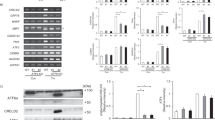Abstract
Heat shock factors (HSF) are the transcriptional activators of the heat shock response. The conversion of constitutively expressed HSF to a form that can bind DNA requires the trimerization of the protein, involving leucine zipper interactions as shown for yeast,Drosophila, chicken and human HSFs. Like other metazoan HSFs, the endogenousArabidopsis HSF displays heat shock-inducible DNA-binding activity in gel retardation assays. The heat shock-inducible binding of a recombinantArabidopsis HSF (ATHSF1) expressed inArabidopsis plants suggests that ATHSF1 is the major heat shock factor regulating the heat stress response. However, on transient expression inDrosophila and human cells, ATHSF1 fails to exhibit proper regulation, as demonstrated by constitutive binding to DNA, and by constitutive expression of a chloramphenicol acetyltransferase (CAT) reporter gene under the control of theDrosophila hsp70 promoter. These results suggest that the regulation of ATHSF1 is normally dependent on a specific factor that inhibits the DNA-binding and transcriptional activities under non-heat shock conditions.
Similar content being viewed by others
References
Amin J, Ananthan J, Voellmy R (1988) Key features of heat shock regulatory elements. Mol Cell Biol 8:3761–3769
Baler R, Dahl G, Voellmy R (1993) Activation of human heat shock genes is accompanied by oligomerization, modification, and rapid translocation of heat shock transcription factor. Mol Cell Biol 13:2486–2496
Bunch TA, Grinblat Y, Goldstein LS (1988a) Constitutive expression vector for human cells. Nucleic Acids Res 16:1059–1061
Bunch TA, Grinblat Y, Goldstein LS (1988b) Characterization of an endogenous methallothionein gene in culturedDrosophila melanogaster cells. Nucleic Acids Res 16:1043–1058
Clos J, Westwood JT, Becker PB, Wilson S, Lambert K, Wu C (1990) Molecular cloning and expression of a hexamericDrosophila heat shock factor subject to negative regulation. Cell 63:1085–1097
Clos J, Rabindran S, Wisniewski J, Wu C (1993) Induction temperature of human heat shock factor is reprogrammed in aDrosophila cell environment. Nature 364:252–255
Gorman CM, Moffat LF, Howard BH (1982) Recombinant genomes which express chloramphenicol acetyltransferase in mammalian cells. Mol Cell Biol 2:1044–1051
Hübel A, Schöffi F (1994)Arabidopsis heat shock factor: isolation and characterization of the gene and the recombinant protein. Plant Mol Biol 26:353–362
Jakob U, Gaestel M, Engel K, Buchner J (1993) Small heat shock proteins are molecular chaperones. J Biol Chem 268:1517–1520
Jefferson RA (1987) Assaying chimaeric genes in plants: The GUS gene fusion system. Plant Mol Biol Rep 5:387–405
Larson JS, Schuetz TJ, Kingston RE (1988) Activation in vitro of sequence specific DNA binding by a human regulatory factor. Nature 335:372–375
Morimoto RI (1993) Cells in stress: transcriptional activation of heat shock genes. Science 259:1409–1410
Morimoto RI, Tissieres A, Georgopoulos C (eds) (1990) The stress response: functions of the proteins and perspectives. Stress proteins in biology and medicine. Cold Spring Harbor Laboratory Press, Cold Spring Harbor, NY, pp 1–36
Mosser DD, Theodorakis NG, Morimoto RI (1988) Coordinate changes in heat shock element-binding activity and Hsp70 gene transcription rates in human cells. Mol Cell Biol 8:4736–4744
Mosser DD, Kotzbauer PT, Sarge KD, Morimoto RI (1990)In vitro activation of heat shock transcription factor DNA-binding by calcium and biochemical conditions that affect protein conformation. Proc Natl Acad Sci USA 87:3748–3752
Nocera PP, Dawid IB (1983) Transient expression of genes introduced into cultured cells ofDrosophila. Proc Natl Acad Sci USA 80:7095–7098
Pelham HRB (1982) A regulatory upstream promoter element in theDrosophila hsp70 heat-shock gene. Cell 46:959–961
Rabindran S, Haroun R, Clos J, Wisniewski J, Wu C (1993) Regulation of heat shock factor trimer formation: role of a conserved leucine zipper. Science 259:230–234
Sorger PK (1991) Heat shock factor and heat shock response. Cell 65:363–366
Sorger K, Nelson HCM (1989) Trimerization of a yeast transcriptional activator via a coiled coil motif. Cell 59:807–813
Treuter E, Nover L, Ohme K, Scharf K-D (1993) Promoter specificity and deletion analysis of three heat stress transcription factors of tomato. Mol Gen Genet 240:113–125
Valvekens D, Montagu M, Lijsebettens M (1988)Agrobacterium tumefaciens-mediated transformation ofArabidopsis thaliana root explants by using kanamycin selection. Proc Natl Acad Sci USA 88:5536–5548
Vuister GW, Kim S-J, Orosz A, Marquardt J, Wu C, Bax A (1994a) Solution structure of the DNA-binding domain ofDrosophila heat shock transcription factor. Structural Biol (in press)
Vuister GW, Kim S-J, Wu C, Bax A (1994b) NMR evidence for similarities between the DNA-binding regions ofDrosophila melanogaster heat shock factor and the helix-turn-helix and HNF/fork head families of transcription factors. Biochemistry 33:10–16
Westwood JT, Wu C (1993) Activation ofDrosophila heat shock factor: conformational change associated with a monomer to trimer transition. Mol Cell Biol 13:3481–3486
Wu C, Zimarino V, Tsai B, Walker B, Wilson S (1990) Transcriptional regulation of heat shock genes. In: Morimoto RI, Tissieres G, Georgopoulus C (eds) Stress proteins in biology and medicine. Cold Spring Harbor Laboratory Press, Cold Spring Harbor, NY, pp 429–442
Xiao H, Lis JT (1988) Germline transformation used to define key features of the heat shock response element. Science 239:1139–1142
Zimarino V, Wilson S, Wu C (1990) Antibody-mediated activation ofDrosophila heat shock factorin vitro. Science 249:546–549
Author information
Authors and Affiliations
Additional information
Communicated by H. Saedler
Rights and permissions
About this article
Cite this article
Hübel, A., Lee, J.H., Wu, C. et al. Arabidopsis heat shock factor is constitutively active inDrosophila and human cells. Molec. Gen. Genet. 248, 136–141 (1995). https://doi.org/10.1007/BF02190794
Received:
Accepted:
Issue Date:
DOI: https://doi.org/10.1007/BF02190794




